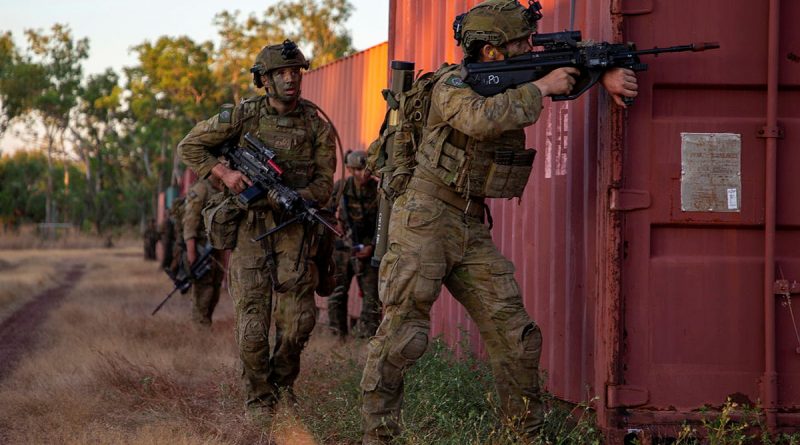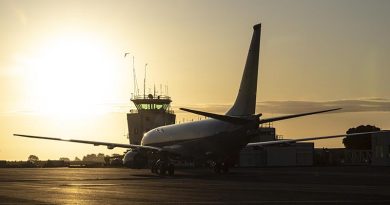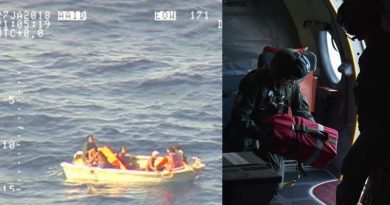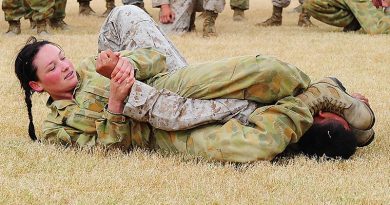Exercise flags shift in focus to the Top End

It’s always a good time to be a soldier in Darwin.
CAPTION: Soldiers from the 5th Battalion, Royal Australian Regiment, 1st Combat Engineer Regiment, the 1st Battalion, Royal Ghurkha Rifles, and Marine Rotational Force – Darwin conduct an urban clearance serial in the Mount Bundey Training Area, NT. Story by Dan Mazurek. Photo by Captain Annie Richardson.
Clouds of red dust waft over Centre Road. Osprey tilt-rotors are thwumping the air. Missiles, mortars and rounds of every calibre scream through open traces. Ramps are dropping on contracted barges, plunging M113s into shallow waters. Bolts are actioned to the “ping” of spent casings as snipers from three countries methodically engage targets. Zodiacs full of soldiers, packs and weapons whip up ocean spray as they move towards beach objectives.
There was a lot going on in the Northern Territory last month as Exercise Predator’s Walk, 1st Brigade’s major training exercise for the season, took place in Darwin, the Tiwi Islands and the Mount Bundey Training Area.
Big changes are underway for 1st Brigade soldiers as the brigade’s transition to the shallow waters has meant that, unlike previous Predator exercises, this year’s iteration incorporated littoral operations into most aspects.
Brigade Commander Brig Nick Foxall is keenly aware of just how swiftly the changes are coming.
“Government is clearly telegraphing a need for us to get after these initiatives quickly and we’re seeing a rapid increase in pace as we move forward,” he said.
Finishing at the start of June, Exercise Predator’s Walk was a cluster of individual unit exercises with allies from the United States Marine Corps (USMC) Marine Rotational Force Darwin (MRF-D) and the 1st Battalion, Royal Gurkha Rifles (1RGR).
The 8th/12th Regiment, Royal Australian Artillery portion, Exercise Thunder Walk, had the regiment lobbing 155mm high explosive shells alongside MRF-D gun detachments, firing at high angles and delivering conventional and precision-guided munitions.
5th Battalion, the Royal Australian Regiment concurrently ran both exercises Tiger Walk and Pacific Kukri, conducting dismounted infantry training with MRF-D and 1RGR. This included an amphibious insertion from Larrakeyah to the Elisabeth River, ending with a night-time urban assault through a civilian built-up area.
1st Combat Engineer Regiment supported all aspects of the exercise building roads and elaborate fortified trench systems, clearing booby traps and carrying out demolitions ranges and urban breaching with fellow USMC sappers. The unit then exercised its new littoral engineer recon squadron, operating from LCM-8s off the southern coast of Bathurst Island.
Recon teams inserted by Zodiac onto the shore near several key objectives to assess bridges, port and fuel facilities.
Meanwhile, 1st Combat Service Support Battalion exercised its ability to deliver logistics via increasingly longer and tighter supply lines, mimicking the challenges of supporting a brigade dispersed by large spans of ocean.

CAPTION: Sappers from the 1st Combat Engineer Regiment drive M113 AS4 armoured personnel carriers off the SS Jane Virgo to a ramp in Point Stuart as part of Exercise Predator’s Walk. Photo by Corporal Tenikah Mills
Delivering vehicles, soldiers and materiel by sea, via contracted barge, meant adapting (often on the fly) to a variety of new challenges, not the least of which were tides, sea states and beach landings.
Finally, enabling the brigade’s command-and-control (C2) capability afloat, 1st Combat Signal Regiment installed one of the two brigade HQ C2 nodes onto a floating, moveable platform proving their ability to mount an agile and mobile nautical headquarters.
The three key takeaways from Exercise Predator’s Walk, which will be reinforced in the upcoming Exercise Predator Run, were the importance of working with partners, adapting to the littoral environment, and the fact it was and remains a learning process.

CAPTION: An Australian Army Joint Fire Observer from the 8th/12th Regiment, Royal Australian Artillery observes the fall of a round from the M777 howitzer from a hide during Exercise Predator’s Walk. Photo by Corporal Tenikah Mills.
Not everything worked perfectly the first time. Occasionally there were failures. From these challenges, however, there was a lot of learning.
“Darwin is very important for our nation,” Brig Foxall said.
“It is closer to the Indonesian archipelagic region than it is to Canberra. It is our link to our primary trade routes. It is our link to our regional partners.”
Darwin is a community closely tied to its military heritage, and one that will only grow in relevance and importance in the coming years.
“The 1st Brigade loves working in Darwin. The people of Darwin are wonderful, kind and caring to our families, and we are looking forward to continuing and developing this profound relationship,” Brig Foxall said.
.
.

.
.





